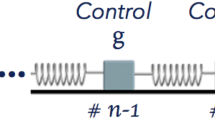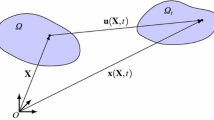Abstract
Purpose
We present a scheme to characterize the defects within a one-dimensional spring–mass system comprised of an arbitrary number of bodies with otherwise uniform masses connected in series by springs using only a discrete set of vibrational data of the first body.
Methods
The system of ordinary differential equations modeling spring–mass systems was analyzed using the Laplace transform with the unknown mass and location of the defects as parameters. We propose a two-phase strategy to determine these unknown parameters using a set of discrete measurements of the longitudinal displacements of the first mass after the system is excited by a Dirac \(\delta\) impulse on the first mass. The Z-transform of the discrete time-measurements is used to obtain an approximation for the Laplace-domain solution curve of the vibration of the first body. First, we show how the poles of this simulated data can be used to determine the masses of the defects. Then the location of these defects were calculated using an optimization routine.
Results
We also show several simulations with two defects highlighting the instances when the scheme is highly accurate as well as its limitations. In these cases, the algorithm was able to predict the mass and locations accurately.
Conclusions
In this paper, we were able to design a stable numerical scheme that can characterize the defects, i.e., estimate their masses and locations, using only a discrete set of vibrational data of the first mass.








Similar content being viewed by others
Availability of data and material
Not applicable.
Code availability
Not applicable.
References
Akulenko LD, Nesterov SV (2014) Mass defect influence on the longitudinal vibration frequencies and mode shapes of a beam. Mech Solids 49:104–111
Bae J-S, Hwang J-H, Kwag D-G, Park J, Inman DJ (2014) Vibration suppression of a large beam structure using tuned mass damper and eddy current damping. Shock Vib 1–10:2014
Caniato M, Bettarello F, Marsich L, Ferluga A, Sbaizero O, Schmid C (2016) Impulse response method for defect detection in polymers: description of the method and preliminary results. Polym Test 55:78–87
Clark W (2000) Vibration control with state-switched piezoelectric materials. J Intell Mater Syst Struct 11(4):263–271
Corr L, Clark W (2003) A novel semi-active multi-modal vibration control law for a piezoceramic actuator. J Vib Acoust 125(2):214–222
Deymier P, Runge K (2016) One-dimensional mass-spring chains supporting elasticwaves with non-conventional topology. Crystals 6(4):44
Dove MT (2011) Introduction to the theory of lattice dynamics. JDN 12:123–159
Egarguin NJA, Meklachi T, Onofrei D, Harari-Arnold ND (2020) Correction to: Vibration suppression and defect detection schemes in 1D linear spring-mass systems. J Vib Eng Technol 8:621
Egarguin NJA, Meklachi T, Onofrei D, Harari-Arnold ND (2020) Vibration suppression and defect detection schemes in 1d linear spring-mass systems. J Vib Eng Technol 8:489–503
El Saif M, Foda MA (2001) Vibration suppression of a beam structure of intermediate masses and springs. J Sound Vib 256(4):629–645
Faleski Michael C (2006) Transient behavior of the driven rlc circuit. Am J Phys 74(5):429–437
Getachew G (2018) A review of simple harmonic motion for mass spring system and its analogy to the oscillations in lc circuit. J Phys Chem Sci 6(3)
He ZC, Xiao X, Li E (2017) Design for structural vibration suppression in laminate acoustic metamaterials. Compos Part B Eng 131:237–252
Horn RA, Johnson CR (2013) Matrix analysis, 2nd edn. Cambridge University Press, Cambridge
Jarrousse O (2012) Modified mass–spring system for physically based deformation modeling. Ph.D. thesis
Joannopoulos JD, Johnson SG, Winn JN, Meade RD (2008) Photonic crystals: molding the flow of light, 2nd edn. Princeton University Press, Princeton
Li T, Li Q, Liu T (2019) An actuated dissipative spring-mass walking model: predicting human-like ground reaction forces and the effects of model parameters. J Biomech 90:58–64
Liu T, Bargteil AW, O’Brien JF, Kavan L (2013) Fast simulation of mass–spring systems. ACM Trans Gr 32(6):1–7
Martin WC, Wu A, Geyer H (2015) Robust spring mass model running for a physical bipedal robot. In: 2015 IEEE international conference on robotics and automation (ICRA), Seattle, WA, USA, pp 6307–6312
Minaya R, Ponce Y (2017) Applications of spring–mass model on crystalline lattices. 09
Morgan D, Qiao S (2008) Accuracy and stability in mass-spring systems for sound synthesis. In: Proceedings of C3S2E-08, pp 1–12
Nealan A, Muler M, Keiser R, Boxerman E, Carlson M (2005) Physically based deformable models in computer graphics. Comput Gr Forum 25(4):809–836
Nedel L, Thalmann D (1998) Real time muscle deformations using mass-spring systems. In: Proceedings of the computer graphics international, pp 157–177
Patel VN, Tandon N, Pandey RK (2012) Defect detection in deep groove ball bearing in presence of external vibration using envelope analysis and duffing oscillator. Measurement 45(5):960–970
Peng H, Frank Pai P (2014) Acoustic metamaterial plates for elastic wave absorption and structural vibration suppression. Int J Mech Sci 89:350–361
André Preumont (2011) Vibration control of active structures, an introduction. Solid mechanics and its applications, 3rd edn. Springer, Berlin
Qin Y, Xiang C, Wang Z, Dong M (2017) Road excitation classification for semi-active suspension system based on system response. J Vib Control 24(13):2732–2748
Radetzky A, Nurnberger A, Teistler M, Pretschner DP (1999) Elastodynamic shape modeling in virtual medicine. In: Proceedings shape modeling international ’99. International conference on shape modeling and applications, Aizuwakamatsu, Japan, pp 172–178
Taylor MJD, Beneke R (2012) Spring mass characteristics of the fastest men on earth. Int J Sports Med 33:667–670
Wang HP, Mustafa GIY, Tian Y (2018) Model-free fractional-order sliding mode control for an active vehicle suspension system. Adv Eng Softw 115:452–461
Yang J, Shang S (2013) Cloth modeling simulation based on mass spring model. Appl Mech Mater 310:676–683
Yao S, Zhou X, Hu G (2008) Experimental study on negative mass effective mass in a 1d mass-spring system. New J Phys 10(4):1–4
Zerbato D, Galvan S, Fiorini P (2007) Calibration of mass spring models for organ simulations. In: 2007 IEEE/RSJ international conference on intelligent robots and systems, San Diego, CA, USA, pp 370–375
Zhang S, Gu L, Huang P, Xu J (2005) Real-time simulation of deformable soft tissue based on mass-spring and medial representation. In: Computer vision for biomedical image applications, a workshop of ICCV2005, LNCS 3875, pp 419–426
Zhenfang C, Bing H (2012) Research of fast cloth simulation based on mass–spring model. In: National conference on information technology and computer science (CITCS 2012), Lanzhou, China
Funding
Larry Guan was supported by the University of Houston through an Undergraduate Research Fellowship.
Author information
Authors and Affiliations
Corresponding author
Ethics declarations
Conflict of interest
The authors do not have conflicts of interest or competing interests.
Additional information
Publisher's Note
Springer Nature remains neutral with regard to jurisdictional claims in published maps and institutional affiliations.
Rights and permissions
About this article
Cite this article
Egarguin, N.J.A., Guan, L. & Onofrei, D. Defect Characterization in a 1D Spring Mass System Using the Laplace and Z-Transforms. J. Vib. Eng. Technol. 10, 1121–1134 (2022). https://doi.org/10.1007/s42417-022-00433-y
Received:
Revised:
Accepted:
Published:
Issue Date:
DOI: https://doi.org/10.1007/s42417-022-00433-y




